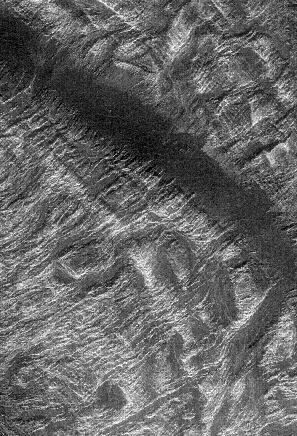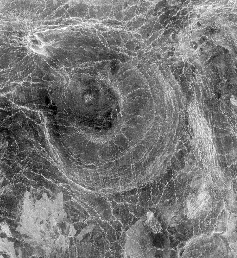Tectonic Motions on Venus
- Very young surface, witnessed by the small number of impact craters
- Evidence of recent Lava flows, suggesting liquid mantle is near surface.
- Distortions and Surface features consistent with crust movement and mantle convection.
Recall, Venus has a similar mass and radius to Earth, meaning internal heating of the core still exists like on Earth, giving it a molten rocky mantle. Venus also has an Fe/Ni core like Earth--though NO Magnetic field! This is because it doesn't spin fast enough.
The upper crust is being moved around by what is assumed to be a convective mantle, however, the crust simply does not move as individual plates. The tectonic features on Venus, are for this reason, much smaller.

There are three major mountain belts on Venus, with elevations of 5-8 km. However, there is not a strong distinction between continents and ocean basins, like on Earth, where its both compositional and topographical.
Mountain belts (in red/yellow) and low regions (in blue) on Venus do not show the same relationship to tectonic features as on Earth, such as mountain ranges where plates are pushing together on Earth, or linear structures outlining fault lines or subduction zones. Note, there is no liquid water on Venus! The image above is false color to show the relative elevation of the crust.
 <-- Large scale Tectonic Features
<-- Large scale Tectonic Features
Several tectonic events formed this complex terrain, part of the
interior of Ovda Regio. An underlying fabric of ridges and valleys
spaced 10-20 km (6-12 mi) apart may have caused
compression of the crust at right angles to the ridge. The largest valleys,
extending 20 km (12 mi) wide across the image,
were filled with dark material, probably lava. The complexity of Ovda
Regio attests to a long history of tectonic deformation.

Corona -->
Located in Lada Terra, Selu Corona measures 350 km (210 mi) in diameter.
Coronae are circular to elliptical
features marked by a ring of concentric ridges and result
from the flow of heat in the planet's
interior. As hot material rises, it weakens the upper crust layers,
causing the surface to dome upwards.
When the region cools, the dome subsides. As the upper
layers rise and fall, they are subjected to
stresses that crack the surface, creating both circular and radial
fractures.